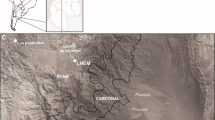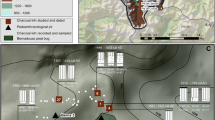Abstract
In close-to-nature silviculture one strives to derive the advantages of the natural adaptations of tree species to different growth conditions. Evidence of the natural distribution of tree species is obtained through vegetation science (recent ground vegetation, primeval forest relicts), studies of old written sources, and pollen and macrofossil analyses. Here we have analysed macrofossil samples of charcoal kiln sites and the recent ecological conditions in the vicinity of these sites, as well as secondary written sources on forest and land-use history. From charcoal analysis of kiln sites we were looking for spatial patterns of past tree species exploitation, with special regard to regional and local differences in the forest growth conditions and the natural wood supply. Therefore, we selected remote forest areas characterised by a high density of kiln sites and significant differences in the ecological conditions. The sample sites ranged over a landscape profile of 40 km, covering many ecological site types. The anthracological results of 181 post-medieval kiln sites were evaluated, considering two spatial scales: the total 40-km profile and a fine-scale profile of 4 km. Considering the charcoal material analysed as a whole, all of the tree taxa to be expected based on the natural conditions were found. The frequencies of the exploited taxa also reflected a natural situation. Wood of the climax vegetation, Fagus, Abies and Picea, was mainly used and all other taxa were quantitatively unimportant. The results for the individual sites showed considerable differences in taxa composition, from which regular spatial patterns of the past tree species distribution were deduced. These regional and local patterns are explained by natural differences in the ecological conditions in the vicinity of the sample sites. At the same time, new indications of the natural tree species composition of our forests are inferred. A pronounced dependency of charcoal production on the local natural wood supply is discernible. No indications of tree species selection or forest degradation could be found.



Similar content being viewed by others
References
Aldinger E, Hübner W, Michiels HG, Mühlhäußer G, Schreiner M, Wiebel M (1998) Überarbeitung der Standortskundlichen regionalen Gliederung im Südwestdeutschen Standortskundlichen Verfahren. Mitt Ver Forstl Standortskd Forstpflanzenzücht 39:5–72
Barnes BV, Zak DR, Denton SR, Spurr SH (1998) Forest ecology, 4th edn. Wiley, New York
Bohley P (2000) Statistik. Einführendes Lehrbuch für Wirtschafts- und Sozialwissenschaftler, 7th edn. Oldenbourg, München
Bonhote J, Davasse B, Dubois C, Izard V, Métailié JP (2002) Charcoal kilns and environmental history in the eastern Pyrenees (France). A methodological approach. In: Thiébault S (ed) Charcoal analysis. Methodological approaches, palaeoecological results and wood uses. Proceedings of the second international meeting of anthracology, Paris, September 2000. BAR (British Archaeological Reports) Int. Series 1063. Archaeopress, Oxford, pp 219–228
Brückner H (1980) Die Entwicklung der Wälder des Schwarzwaldes durch die Nutzung vergangener Jahrhunderte und ihre heutige Bedeutung. In: Liehl E, Sick WD (eds) Der Schwarzwald. Beiträge zur Landeskunde. Konkordia, Bühl/Baden, pp 155–180
Brückner J (1970) Der Wald im Feldberggebiet. Eine wald- und forstgeschichtliche Untersuchung des Südschwarzwaldes (Bühl/Baden). Veröffentl Alem Inst Freiburg i Br 28:1–128
Davasse B (2000) Forêts charbonniers et paysans dans les Pyrénées de l’est du moyen âge à nos jours. Une approche géographique de l’histoire de l’environnement. GEODE (géographie de l’environnement), Toulouse
Ellenberg H (1986) Vegetation ecology of Central Europe, 4th edn. Cambridge University Press, Cambridge
Grosser D (1977) Die Hölzer Mitteleuropas. Ein mikrophotographischer Lehratlas. Springer, Berlin Heidelberg New York
Hasel K (1985) Forstgeschichte. Ein Grundriß für Studium und Praxis (Studientexte Nr. 48). Parey, Hamburg
Hausrath H (1938) Aus der Waldgeschichte des Schwarzwalds. Universitätsreden Freiburg 26:1–27
Hillebrecht ML (1982) Die Relikte der Holzkohlewirtschaft als Indikatoren für Waldnutzung und Waldentwicklung. Untersuchungen an Beispielen aus Südniedersachsen. Göttinger Geogr Abh 79:1–157
Liehl E, Sick WD (eds) (1980) Der Schwarzwald. Beiträge zur Landeskunde. Konkordia, Bühl/Baden
Ludemann T (1994a) Vegetations- und Landschaftswandel im Schwarzwald unter anthropogenem Einfluß. Ber Reinhold-Tüxen-Ges 6:7–39
Ludemann T (1994b) Die Wälder im Feldberggebiet heute. Zur pflanzensoziologischen Typisierung der aktuellen Vegetation. Mitt Ver Forstl Standortskd Forstpflanzenzücht 37:23–47
Ludemann T (1995) Die Holzkohle der montanarchäologischen Grabungen im Revier Sulzburg, Kreis Breisgau-Hochschwarzwald. Archäol Ausgrabungen BW 1994:341–349
Ludemann T (1996) Die Wälder im Sulzbachtal (Südwest-Schwarzwald) und ihre Nutzung durch Bergbau und Köhlerei. Mitt Ver Forstl Standortskd Forstpflanzenzücht 38:87–118
Ludemann T (1999a) Zur Brennstoffversorgung im Bergbaurevier Sulzburg. Archäol Nachr Baden 61/62:131–138
Ludemann T (1999b) Holzkohle—Energiequelle für den Bergbau, Informationsquelle für die Wissenschaft. Archäol Info BW 41:123–129
Ludemann T (1999c) Zur Brennstoffversorgung einer römischen Siedlung im Schwarzwald. In: Brather S, Bücker C, Hoeper M (eds) Archäologie als Sozialgeschichte. Studien zu Siedlung, Wirtschaft und Gesellschaft im frühgeschichtlichen Mitteleuropa. Festschrift für Heiko Steuer. Int. Archaeologie. Studia honoraria 9. Leidorf, Rahden/Westfalen, pp 165–172
Ludemann T (2001) Das Waldbild des Hohen Schwarzwaldes im Mittelalter. Ergebnisse neuer holzkohleanalytischer und vegetationskundlicher Untersuchungen. Alem Jahrb 1999/2000:43–64
Ludemann T (2002a) Historische Holznutzung und Waldstandorte im Südschwarzwald. Freiburg Forstl Forsch 18:194–207
Ludemann T (2002b) Anthracology and forest sites—the contribution of charcoal analysis to our knowledge of natural forest vegetation in south-west Germany. In: Thiébault S (ed) Charcoal analysis. Methodological approaches, palaeoecological results and wood uses. Proceedings of the second international meeting of anthracology, Paris, September 2000. BAR (British Archaeological Reports) Int. Series 1063. Archaeopress, Oxford, pp 209–217
Ludemann T (2003a) Die Rückstände der Köhlerei im Hotzenwald als Informationsquelle zur naturnahen Waldwirtschaft. In: Körner H (ed) Der Hotzenwald. Natur und Kultur einer Landschaft im Südschwarzwald. Lavori-Verlag, Freiburg i Br, pp 95–105
Ludemann T (2003b) Large-scale reconstruction of ancient forest vegetation by anthracology—a contribution from the Black Forest. Phytocoenologia 33:645–666
Ludemann T, Britsch T (1997) Wald und Köhlerei im nördlichen Feldberggebiet/Südschwarzwald. Mitt Badischer Landesver Naturkd Natursch NF 16(3/4):487–526
Ludemann T, Nelle O (2002) Die Wälder am Schauinsland und ihre Nutzung durch Bergbau und Köhlerei. Freiburg Forstl Forsch 15:1–139
Michiels HG (1998) Der Standortswald im südwestdeutschen standortskundlichen Verfahren. Mitt Ver Forstl Standortskd Forstpflanzenzücht 39:73–80
Müller K (ed) (1948) Der Feldberg im Schwarzwald. Naturwissenschaftliche, landwirtschaftliche, forstwirtschaftliche, geschichtliche und siedlungsgeschichtliche Studien. Bielefelds Verlag, Freiburg i. Br.
Müller-Stoll WR (1936) Untersuchungen urgeschichtlicher Holzreste nebst Anleitung zu ihrer Bestimmung. Prähist Zeitschr 27:3–57
Nölken W (2003) Holzkohleanalytische Untersuchungen zur Waldgeschichte der Vogesen im Tal von Miellin. Freiburg. Universitätsblätter 160(2):111–118. Rombach, Freiburg i. Br.
Nölken W (in preparation) Kiln site studies in the Southern Vosges, France. Phd Thesis, University of Freiburg
Oberdorfer E (ed) (1992) Süddeutsche Pflanzengesellschaften. Teil IV: Wälder und Gebüsche. Gustav Fischer, Jena
Peterken GF (1994) The definition, evaluation and management of ancient woods in Great Britain. NNA-Berichte (Norddeutsche Naturschutzakademie) 7(3):102–114
Rackham O (1980) Ancient woodlands, its history, vegetation and uses in England. Arnold, London
REKLIP (Trinationale Arbeitsgemeinschaft Regio-Klima-Projekt/Groupe de travail trinational) (ed) (1995) Klimaatlas Oberrhein Mitte-Süd, 2 Bde. Hochschulverlag, Zürich
Schweingruber FH (1990) Microscopic wood anatomy. Structural variability of stems and twigs in recent and subfossil woods from Central Europe. Swiss Federal Institute for Forest, Snow and Landscape Research (ed), 3rd edn. Flück-Wirth, Birmensdorf Schweiz
Spur SH, Barnes VB (1992) Forest ecology. Reprinted edn. (of 3rd edn. 1980) Krieger, Malabar
Steuer H (1990) Zur Frühgeschichte des Erzbergbaus und der Verhüttung im südlichen Schwarzwald. Literaturübersicht und Begründung eines Forschungs-Programms. Archäologie und Geschichte. Freiburger Forsch 1. Jahrtaus Südwestdeutschland 1:387–415
Steuer H (1991) Erzbergbau im Schwarzwald zur Salierzeit. In: Böhme HW (ed) Siedlungen und Landesausbau zur Salierzeit. Teil 2: In den südlichen Landschaften des Reiches. Sigmaringen, pp 67–96
Steuer H (ed) (1999) Alter Bergbau im Sulzbachtal, Südschwarzwald. Archaeol Nachr Baden 61/62:1–144
Steuer H, Zimmermann U (eds) (1990) Erze, Schlacken und Metalle. Früher Bergbau im Südschwarzwald. Freiburg. Universitätsblätter 109:21–180. Rombach, Freiburg i. Br.
Stoll H (1948) Wald und Waldnutzung im Feldberggebiet. In: Müller K (ed) Der Feldberg im Schwarzwald. Bielefelds Verlag, Freiburg i. Br., pp 423–492
Stoll H (1954) Das Eisenwerk Eberfingen und dessen Holzversorgung. Alem Jahrb 1954:238–278
Stuiver M, Reimer PJ, Bard E, Beck JW, Burr GS, Hughen KA, Kromer B, McCormac G, van der Plicht J, Spurk M (1998) INTCAL98 Radiocarbon Age Calibration, 24000–0 cal BP. Radiocarbon 40 (3):1041–1083
Trenkle H, von Rudloff H (1981) Das Klima im Schwarzwald. In: Liehl E, Sick WD (eds) Der Schwarzwald. Beiträge zur Landeskunde. Konkordia, Bühl/Baden, pp 59–100
Wulf M (1994) Überblick zur Bedeutung des Alters von Lebensgemeinschaften, dargestellt am Beispiel “historisch alter Wälder”. NNA (Norddeutsche Naturschutzakademie) Ber 7(3):3–14
Acknowledgements
This research was supported by the German Federal Research Ministry (BMBF, Bundesministerium für Bildung und Forschung; grant no. 0339768). Most of the anthracological analyses were undertaken by Mrs. Marion Röder. Dr. Edgar Kublin (Forest Research Institute of Baden-Wuerttemberg) and Dr. Manfred Neumann (University of Freiburg) gave valuable support in questions of statistics. We are grateful to the reviewers and the editor for providing many helpful comments on the manuscript.
Author information
Authors and Affiliations
Corresponding author
Rights and permissions
About this article
Cite this article
Ludemann, T., Michiels, HG. & Nölken, W. Spatial patterns of past wood exploitation, natural wood supply and growth conditions: indications of natural tree species distribution by anthracological studies of charcoal-burning remains. Eur J Forest Res 123, 283–292 (2004). https://doi.org/10.1007/s10342-004-0049-z
Received:
Accepted:
Published:
Issue Date:
DOI: https://doi.org/10.1007/s10342-004-0049-z




